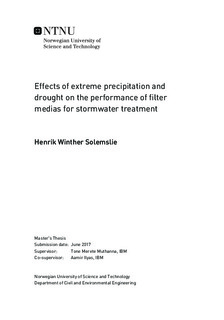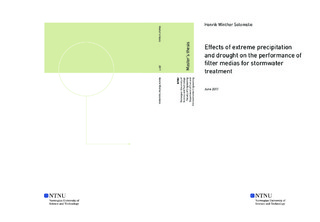| dc.description.abstract | People are moving to the cities, and the climate is becoming more extreme. The growing urbanisation of the world population is causing massive expansion of new urban areas. These areas are filled with impervious surfaces generating large amounts of polluted runoff. In accordance with the low impact development strategy, municipalities are working towards returning urban runoff to its pre-development flow, volume, and purity. This is done with local retention, reduction, and treatment of urban runoff, before it is released to recipients. The pollution in urban runoffs originates mainly from traffic. It comes in both particulate, and dissolved form. The particulate pollutants have for a long time been removed through sedimentation basins. Among the dissolved pollutants are toxic metals such as zinc, lead, copper, and nickel. In the dissolved state these metals are both more bio-available, and more difficult to treat than in the particulate state. One of the most commonly used techniques of removing dissolved toxic metals are by adsorption on an active and commercially available filter media. These filter medias are often expensive, and the removal of dissolved toxic metals are therefore often discarded because of the cost of instalment and maintenance. Therefore, more research is being done to find new alternative adsorption material. New materials need to have documented, not only their removal rate of pollutants, but also that their removal rate are not affected by the extreme climate of the future. At the Department of Civil and Environmental Engineering, at the Norwegian University of Science and Technology, four alternative adsorption materials such as charcoal, pine bark, olivine, and bottom ash coated with iron oxide were selected for testing. The objectives of this thesis was to investigate how these alternative adsorption materials would be affected by extreme precipitation events and drought. The testing was conducted in pilot scale column experiments. In a continuous order, these materials experienced the hydraulic loads of three intensities and four different return periods precipitation events each - 5-minutes, 45-minutes, 180-minutes intensities, and 10-years, 50-years, 100-years, and 200-years return periods. In addition, the material was subjected to four dry periods of 7 to 34 days, interrupted by extreme precipitation events between the dry periods. Samples were taken both during the extreme precipitation simulations and 24 hours after each simulation. The results show that the extreme precipitation events had catastrophic effect on the pine bark and charcoal. The olivine and bottom ash, however, were hardly affected with a stable high removal rate throughout the whole experimental period.
For a filter covering 1 % of the catchment and in combination with a particle removal step, a design depth of 5 cm of either olivine or bottom ash with iron oxide will suffice for removing toxic metals from urban runoff. | |

